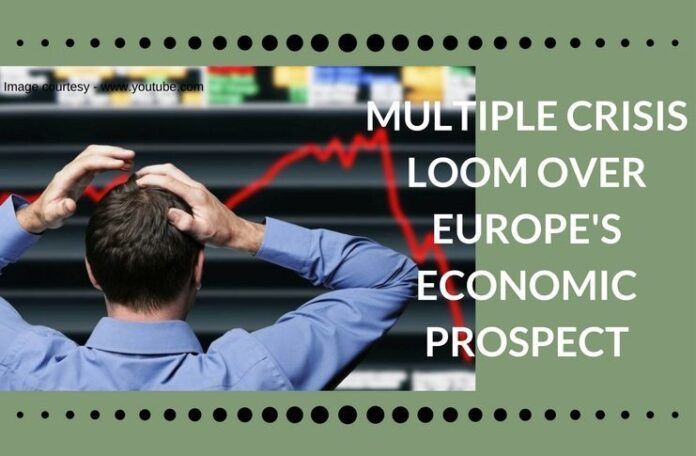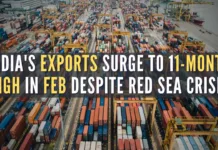
Experts warn that the prospects of economy of Europe would continue to remain lackluster in the near future.
As Europe struggles to cope with its sluggish growth, subdued inflation and double-digit unemployment in the aftermath of a far-reaching sovereign debt crisis, the uncertainties brought by Brexit and an ongoing unprecedented refugee crisis are doomed to add renewed pressure.
WORRISOME ECONOMIC DATA
[dropcap color=”#008040″ boxed=”yes” boxed_radius=”8px” class=”” id=””]O[/dropcap]fficial data showed that growth for Eurozone’s gross domestic product (GDP) saw a quarterly increase of merely 0.6 percent in the first three months this year and waned to only 0.3 percent in the second quarter.
The European Commission, the executive body of the European Union (EU), has recently cut the economic outlook for the 19-country Eurozone, projecting growth of the single currency bloc not reaching more than 1.6 percent for this year, a notch below the earlier 1.7 percent estimate.
Inflation, a figure closely watched by the bloc’s central bank, turned out to be 0.2 percent in July, up from the 0.1 percent one month earlier, recording a rare positive reading this year when the Eurozone fell in deflation several times.
The European Central Bank (ECB) predicted that inflation would stand at just 0.2 percent in 2016 and still off the targeted “below, but close to 2 percent” goal in the next three years.
More of a worry is that the inflation rate for a dozen EU member states remained in negative territory in July, with the Czech Republic being the only one hitting a turning point from negative 0.1 percent in June to 0.5 percent last month, piling pressure for further action by European policymakers.
Another nuisance for Europe has been the high jobless rate which so far saw limited progress and stayed in the double-digits. The latest data from Eurostat, the bloc’s statistic office, showed unemployment at 10.1 percent in the Eurozone in June, while Greece and Spain, where half of young job seekers failed to find work, registered the highest readings at nearly 20 percent.
ONGOING MULTIPLE CHALLENGES
[dropcap color=”#008040″ boxed=”yes” boxed_radius=”8px” class=”” id=””]T[/dropcap]he European economy is now entering its fourth year of recovery, so says the commission, acknowledging Europe was faced with unprecedented difficulties this year.
First of all, the migrant crisis continues to drag down Europe, creating a profound influence on the European economy and society. Migrants or refugees, most of whom are young, are viewed as a complement to Europe’s increasingly aging labor market, although integration problems have surfaced.
Europe is divided on how to deal with the migrant crisis and the split helped stimulate a surge of far-right political parties, fueled conservatism and populism across the continent and took a toll on the bloc’s openness in trade and the economy.
While EU leaders discuss ways to tackle the most severe refugee crisis since the Second World War, they have to contend with another tricky issue brought by Britons who voted to leave the bloc in a referendum in June.
Economists cautioned that Brexit not only potentially shattered the European integration process but is also expected to harm Europe’s growth.
Both the EU and the International Monetary Fund (IMF) have lowered growth forecasts due to the Brexit uncertainty. The commission said the Eurozone was likely to see its growth cut between 0.2 and 0.5 percent by 2017 because of the vote.
[dropcap color=”#008040″ boxed=”yes” boxed_radius=”8px” class=”” id=””]B[/dropcap]ritain would be hit harder, the commission predicted, saying the cumulative negative impact for British GDP would be between about 1 percent and 2.75 percent by 2017.
The IMF in July downgraded growth projections for Eurozone to 1.6 percent this year and 1.4 percent in 2017, adding the world economy for 2016 and 2017 was expected to decelerate to 3.1 percent and 3.4 percent respectively.
“We expect signs of moderate slowdown to emerge in the coming months, mainly reflecting the Brexit fallout via the trade channel and, to a lesser extent, the confidence channel,” said Marco Valli, economist at UniCredit Research.
Moreover, bad bank loans, particularly in Italy and Portugal, could be the next banking crisis in a Europe strained by Brexit.
The share prices of the Italian banking sector have witnessed sharp drops since last year as several banks were saddled with a high portion of bad debts. In the aftermath of the UK referendum, investors were fueled by fears and scrambled to sell shares, leading valuations of EU banks to record lows.
[dropcap color=”#008040″ boxed=”yes” boxed_radius=”8px” class=”” id=””]A[/dropcap] dozen EU Banks from Italy, Ireland, Spain and Austria fared worst in last month’s stress test. The authorities claimed EU banks showed more resilience than two years ago but the conclusion was questioned by many who insisted that the investigated banks fail to represent the whole picture.
Economists expect the Eurozone’s economic outlook to be further downbeat with monetary policy largely reaching its limits. “The ECB’s toolbox is getting emptier,” said Peter Vanden Houte,chief economist at ING Belgium.
Facing multiple challenges including a migrant crisis, the Brexit vote and a banking crisis, Europe is again at a crossroads. Whether European governments can manage to make a breakthrough is leaving question marks over the bloc’s economic future.
Notes: Xinhua-(This story has not been edited by PGurus.com and is generated from a syndicated feed we subscribe to)
- Pentagon cancels aid to Pakistan over record on militants - September 2, 2018
- The curious case of Tamil Nadu’s opposition to NEET - September 4, 2017
- If 2.6 Billion People Go To War: India vs. China - July 22, 2017










